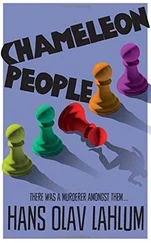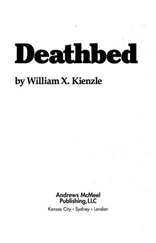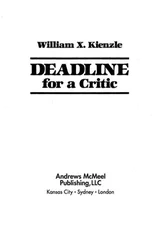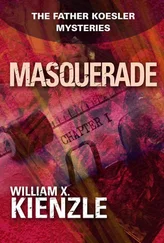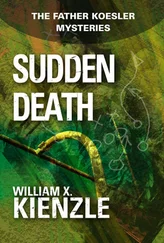William Kienzle - Chameleon
Здесь есть возможность читать онлайн «William Kienzle - Chameleon» весь текст электронной книги совершенно бесплатно (целиком полную версию без сокращений). В некоторых случаях можно слушать аудио, скачать через торрент в формате fb2 и присутствует краткое содержание. Жанр: Криминальный детектив, на английском языке. Описание произведения, (предисловие) а так же отзывы посетителей доступны на портале библиотеки ЛибКат.
- Название:Chameleon
- Автор:
- Жанр:
- Год:неизвестен
- ISBN:нет данных
- Рейтинг книги:5 / 5. Голосов: 1
-
Избранное:Добавить в избранное
- Отзывы:
-
Ваша оценка:
- 100
- 1
- 2
- 3
- 4
- 5
Chameleon: краткое содержание, описание и аннотация
Предлагаем к чтению аннотацию, описание, краткое содержание или предисловие (зависит от того, что написал сам автор книги «Chameleon»). Если вы не нашли необходимую информацию о книге — напишите в комментариях, мы постараемся отыскать её.
Chameleon — читать онлайн бесплатно полную книгу (весь текст) целиком
Ниже представлен текст книги, разбитый по страницам. Система сохранения места последней прочитанной страницы, позволяет с удобством читать онлайн бесплатно книгу «Chameleon», без необходимости каждый раз заново искать на чём Вы остановились. Поставьте закладку, и сможете в любой момент перейти на страницу, на которой закончили чтение.
Интервал:
Закладка:
Koesler chuckled. “It seems as if I just got to my new parish,” he said. “No, I don’t think I’ll be going anywhere soon.”
“New parish?”
“St. Joseph’s-old St. Joseph’s downtown.”
“Near police headquarters?”
“Uh-huh.”
“Nice.”
5
“The cut on your lip looks okay now, but I don’t know about that bruise on your cheek. You could end up with a mean shiner.”
“How many stitches, you figure?” Arnold Carson asked.
Dwight Morgan, right index finger about an inch from Garson’s face, began counting. “Three … four … five. I figure five or six. Hard to tell, Arnie. There might be some more inside your lip.”
Carson tenderly touched his lower lip. “It hurts.” He ran his finger inside the lip. “At least all the teeth are still there.”
“You gonna sue?” Angelo Luca wanted to know.
“The cops?” Carson said. “I been down that road. No future in it,”
“Geez, I feel like it’s my fault,” Luca said.
“Forget it,” Carson replied. “It ain’t your fault. You just saw the write-up in the paper. I’m glad you told us about it.”
“But, geez,” Luca insisted, “if I’d just kept my mouth shut, you wouldna got roughed up.”
“Forget it,” Carson insisted. “It’s just the price we have to pay every once in a while.” He spoke with all the pride a martyr might express.
In this instance, as in so many others, he did consider himself a martyr-a martyr for the good cause of truth, justice, right, and the One, Holy, Catholic and Apostolic Church.
Arnold Carson, a U.S. mail clerk in his early fifties, was, much of the time, an angry man. It had been Carson’s good or bad fate to convert to Catholicism just before the time when, in his opinion, Catholicism was converting to Protestantism.
Carson had been born into a committed Episcopal family. In his youth, he had been an eager participant in all manner of church functions, youth programs, etc. He had even considered the priesthood, But he was not an achieving student. He received and accepted excellent advice from teachers and counselors to lower his academic sights.
When he graduated from high school, Carson became a member of the postal service, first as a part-time flexible employee (PTF), then as a regular employee. Almost by accident he had found his niche in life.
He felt at home, compatible, with things that had specific answers, bottom lines, absolutes. He didn’t admit it to anyone, but he liked addresses. When he worked as a carrier, all he had to do was line up envelopes in numerical order, find the house with the matching number, and the job was done. Stamps were comforting too. One had either sufficient or insufficient postage. And the good old scale would provide that answer. Sufficient and one put it on its way to delivery; insufficient and one returned it.
It was that philosophical attitude which disenchanted Carson with regard to the Episcopal Church-all of Protestantism, for that matter, revealed by his investigation: Too many questions did not have absolute answers.
For instance: Could one be married more than once, more than twice, in the Episcopal Church? It depended.
Then, in I960, at age twenty, he had stumbled onto Catholicism. Catholicism was crammed with absolutes and comfortable numbers. One God, two natures, three persons, four purposes of prayer, five processions in the Trinity, seven sacraments, nine first Fridays, ten Commandments, twelve promises, fourteen Stations of the Cross, and so forth.
Could one marry more than once in the Catholic Church? Of course not. Not unless the petitioner could prove to scrupulous curiosity that a previous marriage was so null and void that it had never happened-or unless one’s spouse died.
Carson searched and studied and investigated and questioned until he thought he had found heaven without benefit of death.
Home! Home was the compulsive, home from insecurity.
Then what to his wondering soul should occur but Vatican II. He couldn’t believe it: They had a perfect system and they fixed it.
Carson didn’t take it lying down. He studied the new monster to the best of his limited ability.
Maybe Martin Luther was right! Maybe “Father Martin,” as he was respectfully treated by the hated new breed, was a saint! What happened to the ordinary magisterium? What happened to actions and thoughts that were evil to their very core? What the hell was situation ethics? What in hell was liberation theology? What happened to the enveloping, mesmerizing Latin? When did nuns start wearing miniskirts? Where did the priest’s lifetime commitment go? What happened to all the goddam absolutes?
Carson had found heaven on earth, and as a result of a four-or five-year meeting in Rome it had been demolished.
Arnold Carson was not amused.
Indeed, he was fighting angry.
He could have taken several tacks. He could quit Catholicism by a simple act of will. Or he could join one of the organizations spawned by and because of Vatican II, organizations for conservatives upset by the council and determined to, in effect, save the Church from itself.
There was Catholics United for the Faith (CUF). Most of the members of this organization were reasonable people, though vigilant and active. They actually pretty much played by the rules set up by the hierarchy.
One program the Catholic Church has wrestled with for the past slightly more than one hundred years is what to do with an infallible Pope when he’s not being infallible. Which is most of the time. Infallibility was defined and adopted (some would say rigged) by the First Vatican Council in 1870. Since then, arguably, there has been only one infallible pronouncement, and that was Pius XII’s regarding Mary’s Assumption into heaven.
All the other thousands of pronouncements by Popes and Popes-with-bishops fall into the category of the ordinary magisterium, or ordinary teaching office of the Church. What to do with that?
Liberal Catholics tend to regard papal pronouncements as being extremely important messages from a unique and well informed source. Only for a most serious reason would such a Catholic eventually disagree with the Pope. But such disagreement is possible.
Not so in the eyes of CUF, or, for that matter, Church law. In effect, if a Catholic disagrees with the ordinary magisterium, he’s not excommunicated; he’s just wrong. And he is advised to go away and pray a while until he sees the light.
Arnold Carson gave CUF a shot and found it inadequate. All very well to write letters to newspapers, call radio talk shows, and argue at meetings. But Carson found such comparative inaction frustrating. He had always believed one had to hit something to get its attention.
So Carson joined the Tridentine Society, so-named for the Latin word for Trent, as in the Council of Trent, Catholicism’s legislative response to the Reformation. Trent (A.D. 1545–1563) was the precursor to Vatican I.
The Tridentines were so much in sync with Carson’s makeup that in no time he became their leader. Under him they became, though small, yet, as they say in sports parlance, a force to be reckoned with.
Arnie Carson was not the type of general to position himself at the rear of the troops and send orders to the front. He was always in the vanguard-as he had been this evening at the funeral home.
On short notice, only Carson and his two most faithful lieutenants, Dwight Morgan and Angelo Luca, were able to assemble less than peaceably outside the Ubly Funeral Home, wherein Helen Donovan’s wake was to be held.
The Tridentines had carried hastily and crudely made signs communicating the general theme that the archdiocese of Detroit equated whores and nuns. And that Cardinal Boyle’s message to his flock was to “Live it up and whore.”
Читать дальшеИнтервал:
Закладка:
Похожие книги на «Chameleon»
Представляем Вашему вниманию похожие книги на «Chameleon» списком для выбора. Мы отобрали схожую по названию и смыслу литературу в надежде предоставить читателям больше вариантов отыскать новые, интересные, ещё непрочитанные произведения.
Обсуждение, отзывы о книге «Chameleon» и просто собственные мнения читателей. Оставьте ваши комментарии, напишите, что Вы думаете о произведении, его смысле или главных героях. Укажите что конкретно понравилось, а что нет, и почему Вы так считаете.

